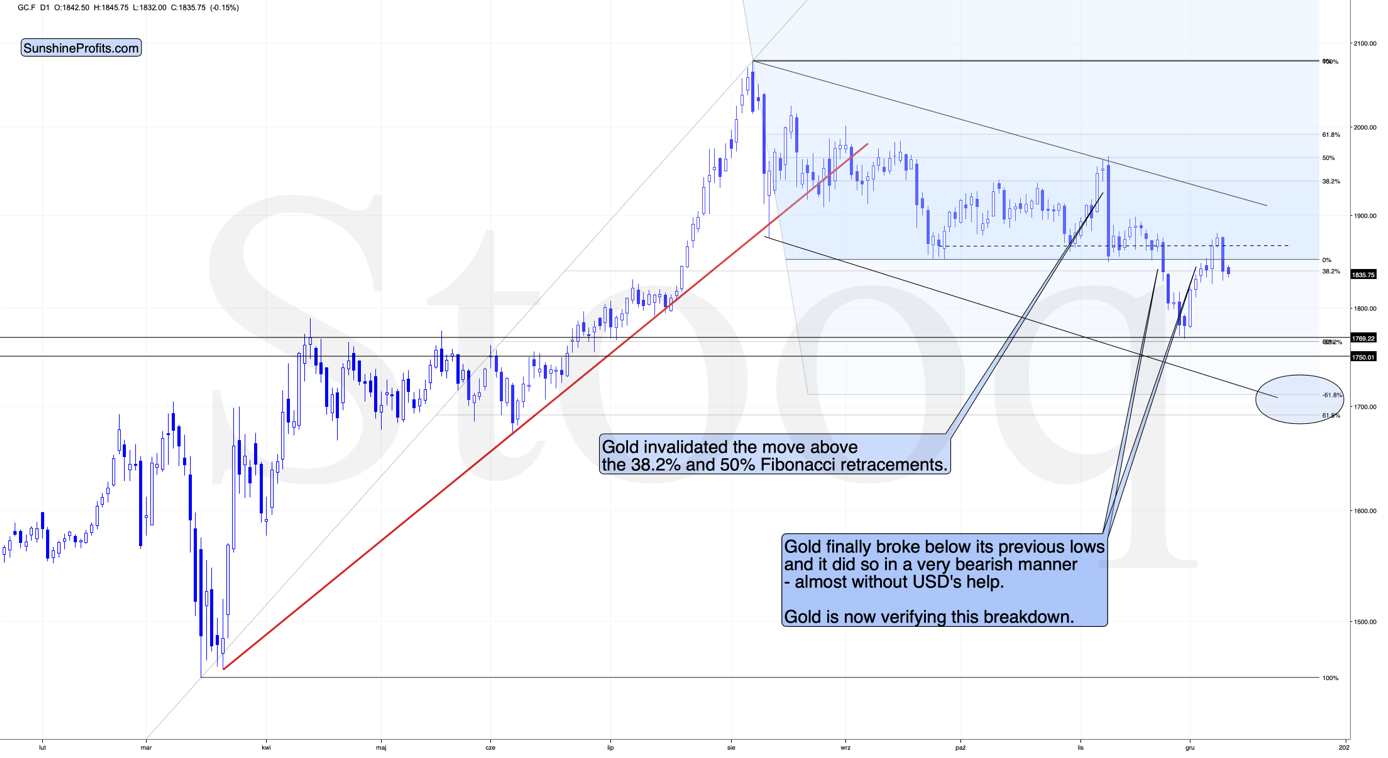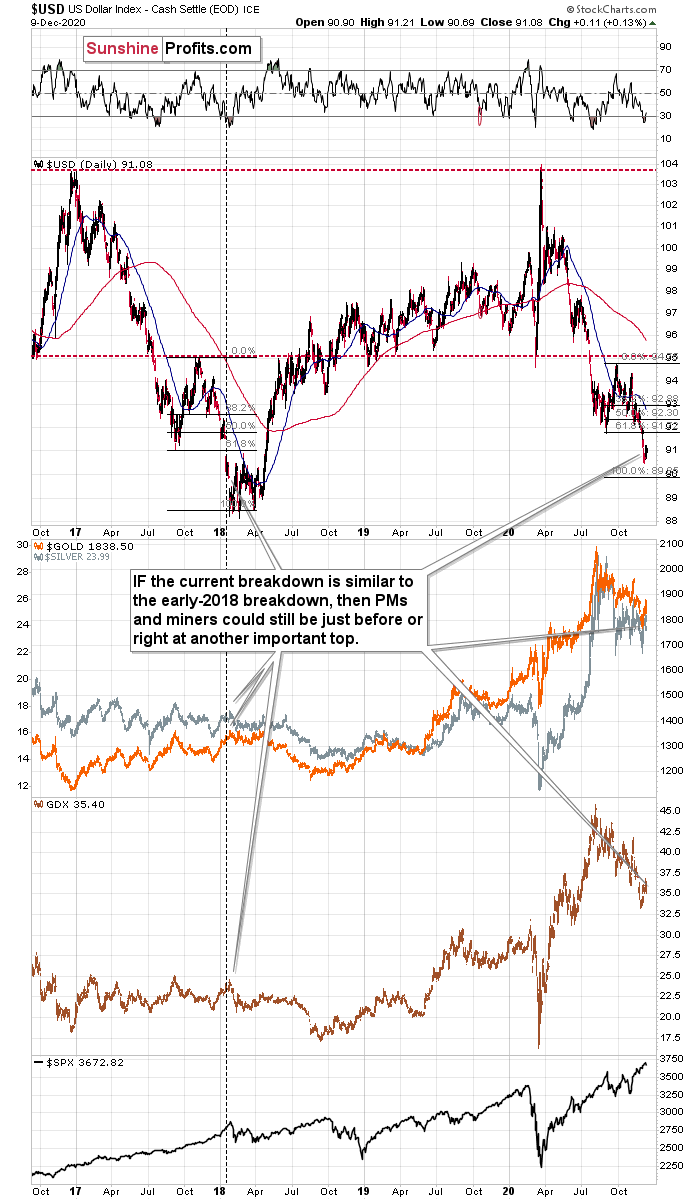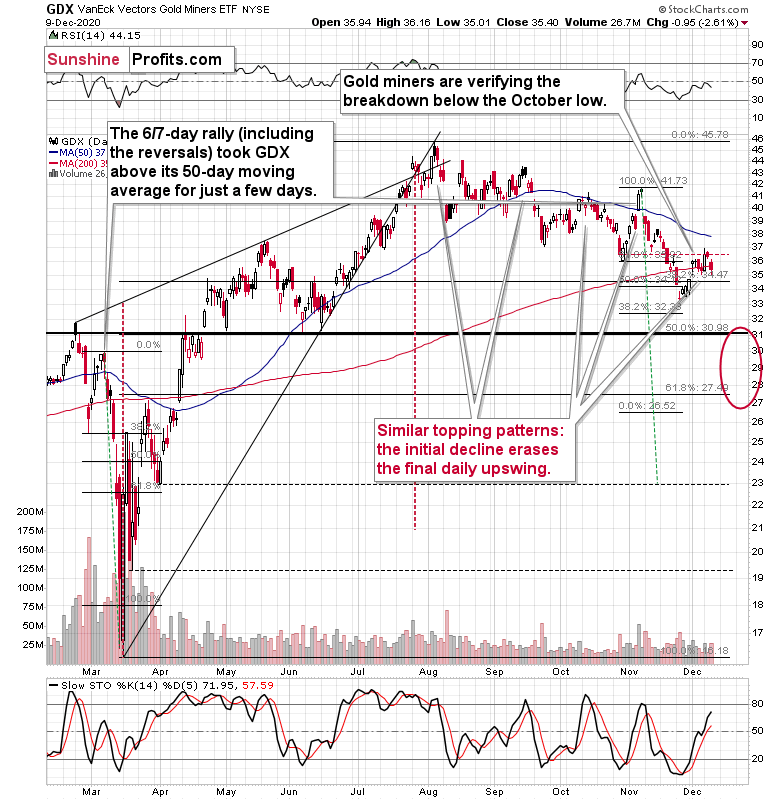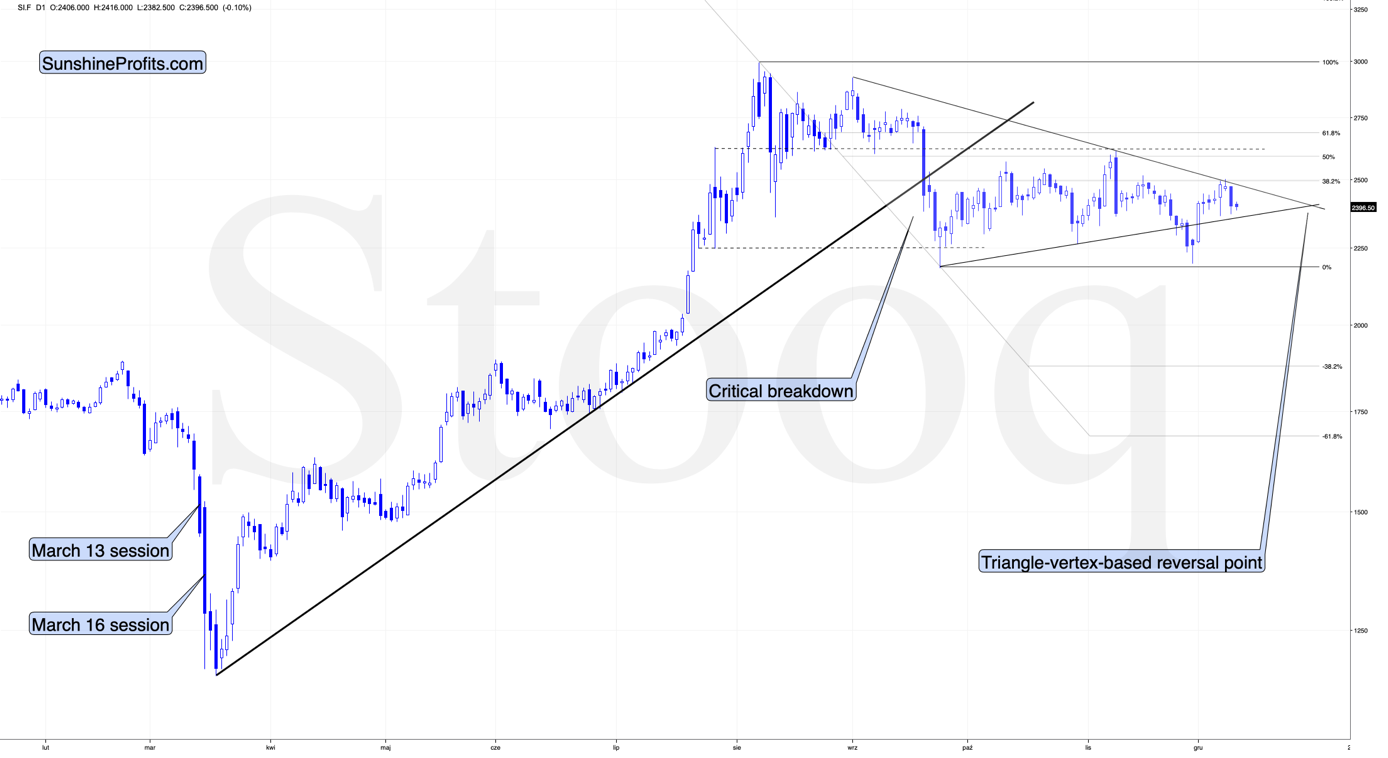Briefly: in our opinion, full (300% of the regular position size) speculative short positions in mining stocks are justified from the risk/reward point of view at the moment of publishing this Alert.
In the previous analyses, I wrote that gold’s short-term potential should be understood as a “possibility” and not a “likelihood”. Yesterday’s price action across the board confirms that this continues to be a valid approach.
The PMs and miners moved lower as a response to a small move higher in the USD Index. This sounds quite normal, but please note that yesterday’s daily gain in the USD Index was almost exactly the same as what we had seen in the previous two trading days. And on those previous two trading days, gold had rallied.
This means that gold’s rally was likely just a technical phenomenon, nothing more. It needed to verify the breakdown below an important support line and that’s exactly what seems to have happened. During this move, silver was particularly strong, and miners were particularly weak, which is exactly what one should expect to see if a given rally is actually a correction within a bigger downtrend. The opposite – strong miners along with relatively weak or regular performance of silver – would have indicated a bigger rally. But that’s now what we saw recently.
On Tuesday (Dec 8), gold closed a little above the lowest daily close of September, but this breakout was invalidated on the very next day (Dec 9). The breakdown appears to have been confirmed which opens the way to additional declines, making the $1,700 a likely target for the next short-term decline.
Please note that at the moment of writing these words, the USD Index erased about half of its Wednesday rally – and gold is slightly down anyway, seemingly having completed its counter-trend rally. Still, if the USDX slides to about 90, gold might re-test the recent highs - but it definitely doesn’t have to.
Speaking of the USD Index, here’s what I wrote about it last Thursday (Dec 3):
The USD Index broke below its previous 2020 lows and this breakdown is almost confirmed. However, since today’s pre-market low (at the moment of writing these words) is 90.78, it seems that the target for the bottom – the 90 level – is at hand. Therefore – and due to also another factor that I’ll discuss shortly – the implications for gold as not as bullish as they might seem at the first sight.
Why would the bottom in the USD Index form at about 90? Because this would be yet another way in which the history could rhyme. In case of the USD Index, we have more of a 1:1 repeat of what we already saw a few years earlier.
Namely, it appears that the USD Index is repeating its 2017 – 2018 decline to some extent. The starting points of the declines (horizontal red line) as well as the final high of the biggest correction are quite similar. The difference is that the recent correction was smaller than it was in 2017.
Since back in 2018, the USDX’s bottom was at about 1.618 Fibonacci extension of the size of the correction, we could expect something similar to happen this time. Applying the above to the current situation would give us the proximity of the 90 level as the downside target.
“So, shouldn’t gold soar in this case?” – would be a valid question to ask.
Well, if the early 2018 pattern was being repeated, then let’s check what happened to precious metals and gold stocks at that time.
In short, they moved just a little higher after the USDX’s breakdown. I marked the moment when the U.S. currency broke below its previous (2017) bottom with a vertical line, so that you can easily see what gold, silver, and GDX (proxy for mining stocks) were doing at that time. They were just before a major top. The bearish action that followed in the short term was particularly visible in the case of the miners.
Consequently, even if the USD Index is to decline further from here, then the implications are not particularly bullish for the precious metals market.
In fact, as the USD Index shows more weakness, gold might simply manage to rally back to its September lows ($1,851 in intraday terms, $1,866 in terms of the daily closing prices, or somewhere between them) and then slide once again. This would be in perfect tune with what happened in early 2018, and also what I discussed previously.
The above remains relevant, especially the part that I bolded. At that time, on December 3, the precious metals sector was indeed just before a top. The GDX ETF was just after a (Dec 2) daily close at $35.97, and yesterday’s (Dec 9) closing price is $35.40. In the meantime, there was a single-time spike.
If the above similarity to early 2018 continues, we can expect the precious metals sector to decline or at least not to rally significantly, despite another move lower in the USD Index.
And speaking of price moves in the GDX ETF, please note that it just performed very similarly to how it had performed at previous price tops.
During the first visible daily rally that we saw after the previous local tops, the GDX erased the final daily gain that it had made before topping. That happened on the following dates: August 7, September 17, October 15, and November 9. And we saw the same thing yesterday (Dec 9). Miners have just erased their December 8 daily rally.
The similarity to the previous post-top patterns indicates that the declines are not yet over. As indicated many times earlier, the next target for the GDX ETF is based on their February high in terms of the closing price – at about $31. Why use the closing price instead of the intraday high? Because the closing price already worked a few times before.
It stopped the rally (for just a while, but still) in mid-April. It stopped the declines in early May and in the first half of June. That’s why when gold slides to $1,700, I expect the GDX to move to about $31.
It will be very interesting to see if during this bottom gold manages to reverse or soar despite a rally in the USD Index. If we see nothing like that, this bottom might generate just a temporary rebound that is then followed by another slide. At this time, this scenario seems quite possible.
While gold and gold miners declined after reaching their previous lows, silver might have topped after reaching its declining resistance line. Or it might have not topped yet. It’s still unclear, because of two things:
- The USD Index could still decline to new 2020 lows and this might (as explained above, it doesn’t have to happen) make the precious metals sector move up once again
- Silver is known for fake breakouts a.k.a. fakeouts right before big moves lower
Moreover, please note that silver has a triangle-vertex-based reversal point in the final part of the month, which could imply that this is where silver forms a final, or temporary bottom. This could have implications also for the rest of the precious metals sector, as its parts tend to move together in the short and medium term.
Given the bearish post-Thanksgiving seasonality in the case of PMs and the tendency for them to form local bottoms in the middle or second half of December, it seems likely that the above is likely to be some kind of bottom.
Overview of the Upcoming Decline
As far as the current overview of the upcoming decline is concerned, I think it has already begun.
During the final part of the slide (which could end within the next 1-5 weeks or so), I expect silver to decline more than miners. That would align with how the markets initially reacted to the Covid-19 threat.
The impact of all the new rounds of money printing in the U.S. and Europe on the precious metals prices is incredibly positive in the long run, which does not make the short-term decline improbable. Markets can and will get ahead of themselves and decline afterward – sometimes very profoundly – before continuing with their upward climb.
The plan is to exit the current short positions in miners after they decline far and fast, but at the same time, silver drops just “significantly” (we expect this to happen in 0 – 3 weeks). In other words, the decline in silver should be severe, but the decline in the miners should look “ridiculous”. That’s what we did in March when we bought practically right at the bottom. It is a soft, but simultaneously broad instruction, so additional confirmations are necessary.
I expect this confirmation to come from gold, reaching about $1,700 - $1,750. If – at the same time – gold moves to about $1,700 - $1,750 and miners are already after a ridiculously big drop (say, to $31 - $32 in the GDX ETF – or lower), we will probably exit the short positions in the miners and at the same time enter short positions in silver. However, it could also be the case that we’ll wait for a rebound before re-entering short position in silver – it’s too early to say at this time. It’s also possible that we’ll enter very quick long positions between those short positions.
The precious metals market's final bottom is likely to take shape when gold shows significant strength relative to the USD Index. It could take the form of a gold’s rally or a bullish reversal, despite the ongoing USD Index rally.
Summary
Summing up, the next big move lower in the precious metals market is definitely underway and it seems that it will take another 1-5 weeks (likely in the second half of December) before the decline ends. It seems that the part of the slide in gold that takes place below $1,700 is going to see a silver catching up with the decline in gold and miners. Last week’s upswing seems to be a relatively normal bounce within a bigger decline. This corrective upswing might have already ended, but it’s possible that we see one additional move higher before the very short-term top is in.
Please note that even Warren Buffett is limiting his exposure to gold.
Despite the recent decline in it, it seems that the USD Index is going to move higher in the following months and weeks, causing gold to decline. At some point gold is likely to stop responding to dollar’s bearish indications, and based on the above analysis, it seems that we might expect this to take place in December.
Naturally, everyone's trading is their responsibility. But in our opinion, if there ever was a time to either enter a short position in the miners or increase its size if it was not already sizable, it's now. We made money on the March decline, and on the March rebound, with another massive slide already underway.
After the sell-off (that takes gold to about $1,700 or lower), we expect the precious metals to rally significantly. The final decline might take as little as 1-5 weeks, so it's important to stay alert to any changes.
Most importantly, please stay healthy and safe. We made a lot of money on the March decline and the subsequent rebound (its initial part) price moves (and we'll likely earn much more in the following weeks and months), but you have to be healthy to enjoy the results.
As always, we'll keep you - our subscribers - informed.
To summarize:
Trading capital (supplementary part of the portfolio; our opinion): Full speculative short positions (300% of the full position) in mining stocks is justified from the risk to reward point of view with the following binding exit profit-take price levels:
Senior mining stocks (price levels for the GDX ETF): binding profit-take exit price: $32.02; stop-loss: none (the volatility is too big to justify a SL order in case of this particular trade); binding profit-take level for the DUST ETF: $28.73; stop-loss for the DUST ETF: none (the volatility is too big to justify a SL order in case of this particular trade)
Junior mining stocks (price levels for the GDXJ ETF): binding profit-take exit price: $42.72; stop-loss: none (the volatility is too big to justify a SL order in case of this particular trade); binding profit-take level for the JDST ETF: $21.22; stop-loss for the JDST ETF: none (the volatility is too big to justify a SL order in case of this particular trade)
For-your-information targets (our opinion; we continue to think that mining stocks are the preferred way of taking advantage of the upcoming price move, but if for whatever reason one wants / has to use silver or gold for this trade, we are providing the details anyway. In our view, silver has greater potential than gold does):
Silver futures downside profit-take exit price: unclear at this time - initially, it might be a good idea to exit, when gold moves to $1,703.
Gold futures downside profit-take exit price: $1,703
Long-term capital (core part of the portfolio; our opinion): No positions (in other words: cash
Insurance capital (core part of the portfolio; our opinion): Full position
Whether you already subscribed or not, we encourage you to find out how to make the most of our alerts and read our replies to the most common alert-and-gold-trading-related-questions.
Please note that we describe the situation for the day that the alert is posted in the trading section. In other words, if we are writing about a speculative position, it means that it is up-to-date on the day it was posted. We are also featuring the initial target prices to decide whether keeping a position on a given day is in tune with your approach (some moves are too small for medium-term traders, and some might appear too big for day-traders).
Additionally, you might want to read why our stop-loss orders are usually relatively far from the current price.
Please note that a full position doesn't mean using all of the capital for a given trade. You will find details on our thoughts on gold portfolio structuring in the Key Insights section on our website.
As a reminder - "initial target price" means exactly that - an "initial" one. It's not a price level at which we suggest closing positions. If this becomes the case (like it did in the previous trade), we will refer to these levels as levels of exit orders (exactly as we've done previously). Stop-loss levels, however, are naturally not "initial", but something that, in our opinion, might be entered as an order.
Since it is impossible to synchronize target prices and stop-loss levels for all the ETFs and ETNs with the main markets that we provide these levels for (gold, silver and mining stocks - the GDX ETF), the stop-loss levels and target prices for other ETNs and ETF (among other: UGL, GLL, AGQ, ZSL, NUGT, DUST, JNUG, JDST) are provided as supplementary, and not as "final". This means that if a stop-loss or a target level is reached for any of the "additional instruments" (GLL for instance), but not for the "main instrument" (gold in this case), we will view positions in both gold and GLL as still open and the stop-loss for GLL would have to be moved lower. On the other hand, if gold moves to a stop-loss level but GLL doesn't, then we will view both positions (in gold and GLL) as closed. In other words, since it's not possible to be 100% certain that each related instrument moves to a given level when the underlying instrument does, we can't provide levels that would be binding. The levels that we do provide are our best estimate of the levels that will correspond to the levels in the underlying assets, but it will be the underlying assets that one will need to focus on regarding the signs pointing to closing a given position or keeping it open. We might adjust the levels in the "additional instruments" without adjusting the levels in the "main instruments", which will simply mean that we have improved our estimation of these levels, not that we changed our outlook on the markets. We are already working on a tool that would update these levels daily for the most popular ETFs, ETNs and individual mining stocks.
Our preferred ways to invest in and to trade gold along with the reasoning can be found in the how to buy gold section. Furthermore, our preferred ETFs and ETNs can be found in our Gold & Silver ETF Ranking.
As a reminder, Gold & Silver Trading Alerts are posted before or on each trading day (we usually post them before the opening bell, but we don't promise doing that each day). If there's anything urgent, we will send you an additional small alert before posting the main one.
Thank you.
Przemyslaw Radomski, CFA
Founder, Editor-in-chief







